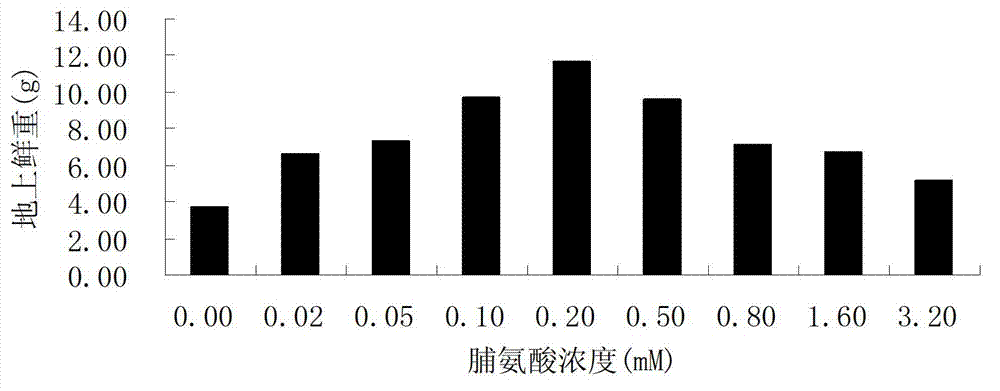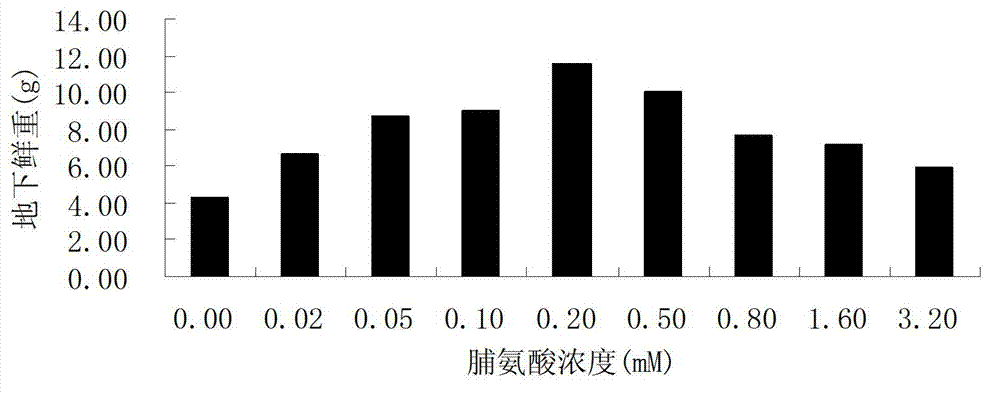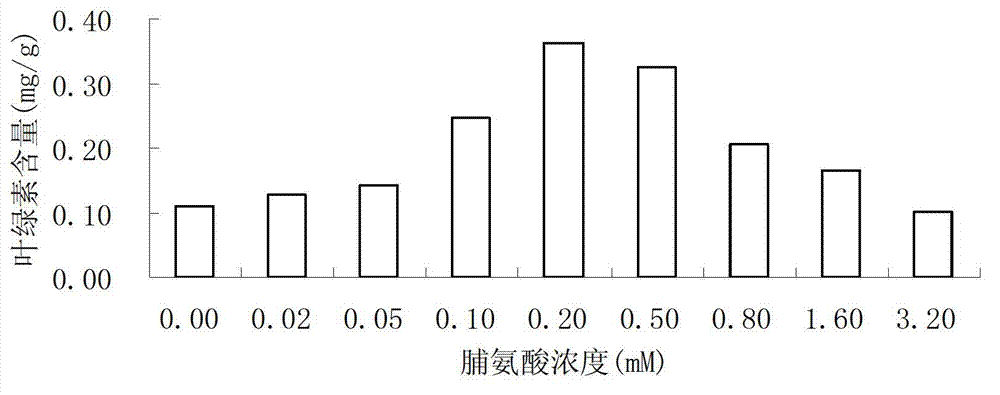Method of improving salt resistance of bluegrass by using exogenous proline
A technology of exogenous proline and proline, which is applied in the field of improving the salt resistance of bluegrass, can solve the problems of general salt resistance effect, long treatment cycle, complicated process, etc. simple effect
- Summary
- Abstract
- Description
- Claims
- Application Information
AI Technical Summary
Problems solved by technology
Method used
Image
Examples
Embodiment 1
[0021] Embodiment 1 Concentration selection test
[0022] Adding 100 mmol / L NaCl to stress Poa annua, the growth of Poa annua was severely inhibited. After 10 days of stress treatment, the aboveground biomass and belowground biomass of Poa annua decreased by 46.0% and 44.8%, respectively, compared with those cultured in normal nutrient solution. Randomly divided into 9 groups.
[0023] Method: Proline solutions with concentrations of 0.02 mmol / L, 0.05 mmol / L, 0.1 mmol / L, 0.20 mmol / L, 0.50 mmol / L, 0.80 mmol / L, 1.60 mmol / L and 3.20 mmol / L were prepared respectively (Pro) solution, pour the solution into the sprayer for foliar application; spray 2 times a day for 3 days. The result is as Figure 1-Figure 4 .
[0024] Salt stress can inhibit the growth of most plants to varying degrees. The results of this experiment also showed that 100 mmol / L NaCl stress treatment significantly inhibited the growth of Poa annua. Adopt the method of the present invention, from Figure 1-F...
Embodiment 2
[0027] Embodiment 2 The selection of spraying material
[0028] Adding 100 mmol / L NaCl to stress Poa annua, the growth of Poa annua was severely inhibited. After 10 days of stress treatment, the aboveground biomass and belowground biomass of Poa annua decreased by 46.0% and 44.8%, respectively, compared with those cultured in normal nutrient solution. Randomly divided into 4 groups.
[0029] Method: Proline solution (Pro) solution, 0.50 mmol / L salicylic acid (SA) solution, 10 mmol / L CaCl 2 Solution, 10μmol / L gibberellin (GA 3 ) solution and injected into the sprayer for foliar spraying; spraying twice a day for 3 days. The result is as Figure 5-Figure 6 .
[0030] From Figure 5 and Figure 6 Visible, SA, GA 3 , CaCl 2 , proline can alleviate the effect of salt stress, SA will be transformed rapidly in plants, and this substance cannot be conducted in the phloem, so it cannot be effectively used; GA 3 The price is relatively high, and it is easy to decompose under ...
Embodiment 3
[0031] Example 3 A method of improving the salt resistance of bluegrass by using proline
[0032] (1) The method is as follows:
[0033] 1) Prepare a proline solution with a concentration of 0.2 mM, inject the solution into the sprayer, and spray on the leaves;
[0034] 2) Select the bluegrass seedling stage for spraying, and the selected date is between May and June;
[0035] 3) Choose the weather without rain and spray for 3 days;
[0036] 4) Spray twice a day, once before 7:00 am and 18:00 pm;
[0037] 5) The amount of spraying is based on the fact that the leaves are wet but not dripping.
PUM
 Login to View More
Login to View More Abstract
Description
Claims
Application Information
 Login to View More
Login to View More - R&D
- Intellectual Property
- Life Sciences
- Materials
- Tech Scout
- Unparalleled Data Quality
- Higher Quality Content
- 60% Fewer Hallucinations
Browse by: Latest US Patents, China's latest patents, Technical Efficacy Thesaurus, Application Domain, Technology Topic, Popular Technical Reports.
© 2025 PatSnap. All rights reserved.Legal|Privacy policy|Modern Slavery Act Transparency Statement|Sitemap|About US| Contact US: help@patsnap.com



